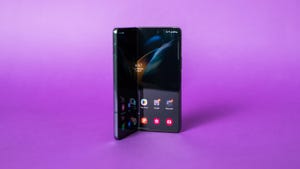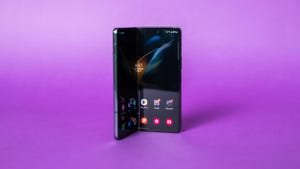
Samsung Galaxy Z Fold 5 Wishlist: Everything I Want to See - CNET
With the Galaxy Z Fold 4, Samsung’s foldable phone took a big step in the right direction thanks to its updated design, Galaxy S22-like camera and new processor. But there are plenty of ways Samsung could further improve its book-style foldable phone.
The biggest change I’m hoping to see in the Galaxy Z Fold 4’s successor (which will likely be called the Galaxy Z Fold 5) is more software that takes advantage of its foldable shape. Having a giant screen that fits in your pocket is great. But Samsung needs to provide a more convincing argument if it truly wants foldables to be appealing to more than just early adopters.
The Galaxy Z Fold is on its fourth generation, yet foldables still haven’t had the breakout moment Samsung has been waiting for. Although sales of foldable phones are growing, they will only account for 1.1% of the overall smartphone market in 2022, according to projections from the International Data Corporation.
Samsung typically releases its new foldable phones in August. Here’s everything I’m hoping to see from the Galaxy Z Fold 5 next year.
More software features

Samsung’s Galaxy Z Fold 4 offers a giant screen that fits in your pocket. But it needs more than that to win people over.
James Martin/CNET
Yes, the Galaxy Z Fold’s design is what makes it noteworthy. But impressive hardware doesn’t mean much without the software to go with it. Samsung has done a lot to improve the way apps work across the Z Fold’s 7.6-inch inner display in the years since its launch. For example, the Z Fold 4 has a dock that sits at the bottom of the screen for quickly accessing apps, as well as the ability to use the bottom half of the screen as a touchpad when in Flex Mode.
The problem is that these features don’t do a great job at convincing users why they should want a foldable phone in the first place. Instead, they just make the process of using apps on the Z Fold slightly easier and more convenient.
I don’t think any company has answered that question adequately just yet, but I have seen some promising attempts. Microsoft’s Surface Duo 2, for example, turns into a digital book when you open the Kindle app, complete with page-turn animations. It’s worth remembering, however, that the Surface Duo is different from the Z Fold since it consists of two separate displays joined together by a hinge. The Galaxy Z Fold 4 is also a much better phone overall thanks to its superior camera and smoother software improvements, among other benefits.
Samsung was among the first to release a foldable phone, meaning it’s had a longer lead time than most competitors in this department. That’s why I’m hoping to see more ambitious features from Samsung in future versions of the Galaxy Z Fold.
An embedded S Pen

The Galaxy Z Fold 4 and Z Fold 3 support the S Pen, but you have to buy it separately.
Patrick Holland/CNET
The S Pen could help Samsung address that critical question of who the Galaxy Z Fold is for. The Galaxy Z Fold 3 and 4 both support the S Pen, but you must buy it separately and there’s no storage mechanism for it. Instead, Samsung should bundle the S Pen with the Galaxy Z Fold 5 and add a way to conveniently store it within or attach it to the device.
Doing so could make the Galaxy Z Fold 5 even more useful for taking notes, sketching and editing documents. That might not be important to everyone, but it could make the Z Fold more appealing to the productivity-oriented crowd that Samsung seems to be targeting. It would also make the Z Fold’s high price a bit easier to swallow since you’ll be getting more for your money.
Samsung hasn’t discussed its plans for the Galaxy Z Fold series. But a report from The Elec says Samsung has cited the addition of an S Pen slot as a key challenge that must be overcome to make foldables more popular. That means Samsung may at least be thinking about bundling the S Pen with its future foldables.
A less noticeable crease

The Galaxy Z Fold 4’s crease still stands out.
James Martin/CNET
Samsung has gradually refined the Z Fold’s design over the years, but the crease hasn’t gone away just yet. Although it’s not always visible, you can feel the crease when running your finger across the screen. Reducing the crease could make the Galaxy Z Fold feel more like a regular tablet when opened.
Samsung may be the leader when it comes to foldable phones, but other companies are making quick progress when it comes to shrinking the crease. Take Huawei and Oppo, the latter of which is one of the world’s biggest smartphone makers.
The screen on Huawei’s Mate XS 2 wraps around the front of the device so that it can function as a regular phone when folded and a tablet when opened — a design that makes the crease barely existent. CNET’s Sareena Dayaram recently tried Oppo’s new Find N2 foldable, writing that she “hardly ever saw or felt the crease.” These advancements make me wish I saw more progress from Samsung in this regard. There’s a chance Samsung may be looking into how to address this, considering The Elec’s report also suggests Samsung is interested in reducing the Z Fold’s crease.
A thinner design

The Galaxy Z Fold 4 still feels thick when closed.
James Martin/CNET
Samsung’s Galaxy Z Fold 4 has a sturdy build and a wide cover screen. But it still feels cumbersome to use as a regular phone when closed. The Galaxy Z Fold 4 measures 0.5 to 0.6 inch thick when folded, whereas the iPhone 14 and Galaxy S22 both measure roughly 0.3 inch thick. That extra bulk might not bother those who primarily use their Galaxy Z Fold unfolded in tablet mode. But it’s another barrier to adoption for those who aren’t yet convinced of the promise of foldable phones.
A lower price

The Galaxy Z Fold 4 is significantly more expensive than your average nonfoldable phone at a regular price.
James Martin/CNET
With a regular price of $1,800, calling the Galaxy Z Fold 4 expensive might be an understatement. You’ll get a discount when trading in an old device, with Samsung listing the 256GB model for $900 with an eligible trade-in. But that still lands at the high end of the spectrum compared to many nonfolding phones, like those in the Galaxy S22 lineup and Pixel 7 family.
Samsung is at least aware of this conundrum. “It’s definitely a challenge that we are tackling, and we will need to tackle,” TM Roh, president and head of Samsung’s mobile experience business, said in an interview with CNET earlier this year regarding the Z Fold’s price.
Foldable phones are still a nascent part of the broader smartphone market, but changes like these could push them closer to becoming viable alternatives to our everyday devices. Samsung helped popularize the big-screen phones we use today with its first Galaxy Note phone back in 2011. It’s trying to do the same with foldables, but there are clearly still challenges to overcome.

